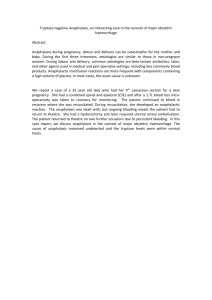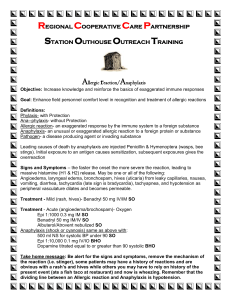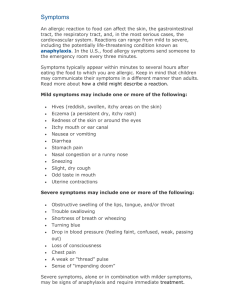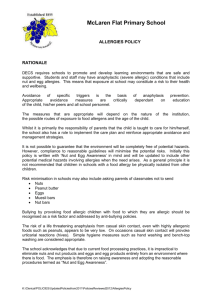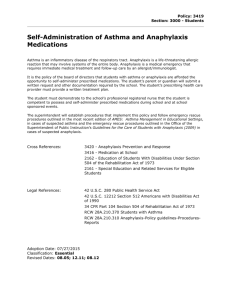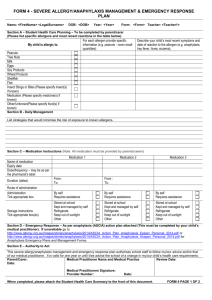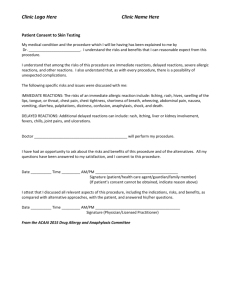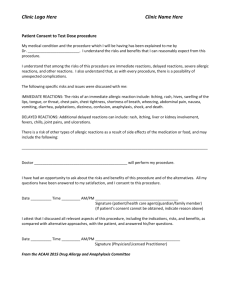Sample Anaphylaxis Management Policy for Child Care Services
advertisement
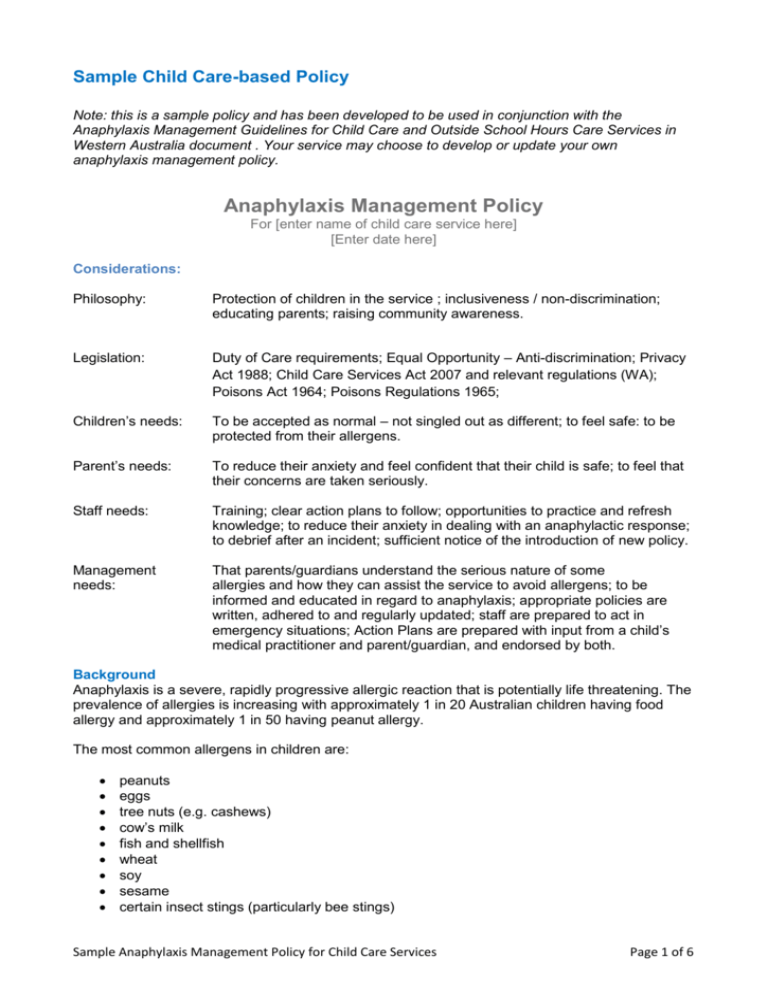
Sample Child Care-based Policy Note: this is a sample policy and has been developed to be used in conjunction with the Anaphylaxis Management Guidelines for Child Care and Outside School Hours Care Services in Western Australia document . Your service may choose to develop or update your own anaphylaxis management policy. Anaphylaxis Management Policy For [enter name of child care service here] [Enter date here] Considerations: Philosophy: Protection of children in the service ; inclusiveness / non-discrimination; educating parents; raising community awareness. Legislation: Duty of Care requirements; Equal Opportunity – Anti-discrimination; Privacy Act 1988; Child Care Services Act 2007 and relevant regulations (WA); Poisons Act 1964; Poisons Regulations 1965; Children’s needs: To be accepted as normal – not singled out as different; to feel safe: to be protected from their allergens. Parent’s needs: To reduce their anxiety and feel confident that their child is safe; to feel that their concerns are taken seriously. Staff needs: Training; clear action plans to follow; opportunities to practice and refresh knowledge; to reduce their anxiety in dealing with an anaphylactic response; to debrief after an incident; sufficient notice of the introduction of new policy. Management needs: That parents/guardians understand the serious nature of some allergies and how they can assist the service to avoid allergens; to be informed and educated in regard to anaphylaxis; appropriate policies are written, adhered to and regularly updated; staff are prepared to act in emergency situations; Action Plans are prepared with input from a child’s medical practitioner and parent/guardian, and endorsed by both. Background Anaphylaxis is a severe, rapidly progressive allergic reaction that is potentially life threatening. The prevalence of allergies is increasing with approximately 1 in 20 Australian children having food allergy and approximately 1 in 50 having peanut allergy. The most common allergens in children are: peanuts eggs tree nuts (e.g. cashews) cow’s milk fish and shellfish wheat soy sesame certain insect stings (particularly bee stings) Sample Anaphylaxis Management Policy for Child Care Services Page 1 of 6 The key to the prevention of anaphylaxis in child care services is knowledge of those children who have been diagnosed as at risk, awareness of allergens, and prevention of exposure to those allergens. Communication between child care services and parents/guardians is important in helping children avoid exposure. Adrenaline given through an adrenaline autoinjector (such as an EpiPen® or Anapen®) into the muscle of the outer mid thigh is the most effective first aid treatment for anaphylaxis. Scope This policy applies to: All children diagnosed by a medical practitioner as being at risk of anaphylaxis; All children enrolled at the service including their parents/guardians; Relevant members of the service community (e.g. volunteers working at the child care service); All staff and the licensee. Policy Statement This child care service is committed to: Providing, as far as practicable, a safe and supportive environment in which children at risk of anaphylaxis can participate equally in all activities; Raising awareness about anaphylaxis and the child care service’s anaphylaxis management policy in the child care community; Engaging with parents/guardians of children at risk of anaphylaxis in assessing risks and developing risk minimisation strategies for the child. The Purpose The aim of this policy is to: Minimise the risk of an anaphylactic reaction occurring at the child care service. Ensure members of staff are adequately trained to respond appropriately and competently to an anaphylactic reaction. Raise awareness about diagnosis throughout the child care community through education and policy implementation. When introducing the Anaphylaxis Management Policy to staff it is important to first meet with them to explain the new policy, what it entails and when it will commence. Give them sufficient notice to ask questions and have any concerns addressed prior to it being introduced. PROCEDURE Identifying allergic children Prior to enrolment or as soon as an allergy is diagnosed, the child care service will develop an Individual Anaphylaxis Health Care Plan for the child in consultation with the child’s parents/guardians and appropriate health professionals. At the time of enrolment parents/guardians will be asked to identify if their child has any special dietary needs. Where special needs are stated, the parent/guardian will be asked to complete a ‘Special Diet Record Form’ (see Appendix 6). This form will be reviewed with the parent/guardian every six months, and a copy will be provided to those staff members who have responsibility for preparing food. Whenever a child with severe allergies is enrolled at the child care service, or newly diagnosed as having a severe allergy, all staff will be informed of: The child’s name and room; Where the child’s ASCIA Action Plan will be located; Where the child’s adrenaline autoinjector is located; Sample Anaphylaxis Management Policy for Child Care Services Page 2 of 6 Which staff member(s) will be responsible for administering the adrenaline autoinjector. New and relief/casual staff will be given information about children’s special needs (including children with severe allergies) during the orientation process. The child care service will discuss the provision of a Medic Alert bracelet for the child at risk of anaphylaxis with parents/guardians. Staff Training An appropriate number of staff will be trained in the prevention, recognition and treatment of anaphylaxis in child care settings, including the use of adrenaline autoinjectors. Each child care service will need to determine which of their staff should be trained to ensure that someone in close proximity to the child is always on hand to act in an emergency. In a small service this may mean that all staff should be trained, whilst in a larger service it may be sufficient for only those staff who work with the child to be trained. Best practice, however, would be for all staff to undergo training so there is always support in any situation. The child care service will ensure the Food Coordinator is trained in managing the provision of meals for a child with allergies, including high levels of care in preventing cross contamination during storage, handling, preparation and serving of food. Training will also be given in planning appropriate menus including identifying written and hidden sources of food allergens on food labels. The child care service will have available adrenaline autoinjector trainers to allow staff to practice using the devices. Anaphylaxis emergency procedures will be conducted and evaluated every six months to ensure staff are confident in the procedure and able to act in an emergency. Emergency Procedures The child’s Individual Anaphylaxis Health Care Plan should be completed in consultation with the child’s parents/guardians. Such consultation includes: approval of the Plan consent to display the child’s ASCIA Action Plan consent for the information contained within the Plan to be made available to both child care staff and emergency medical personnel (if necessary) The child’s Individual Anaphylaxis Health Care Plan must include information relating to the immediate transport to hospital in an ambulance after an anaphylactic reaction. Repeat episodes of anaphylaxis may necessitate the child requiring additional medical treatment. The child’s ASCIA Action Plan will be placed in a prominent position. This will ensure it can be regularly read by child care staff where the child may be present during the day. The need to display the child’s ASCIA Action Plan will be fully discussed with the child’s parents/guardians and their authorisation obtained for this. The Supervising Officer will inform the child care service management of the agreed Individual Anaphylaxis Health Care Plan for the child and obtain their endorsement for the Plan to proceed. All information on the child’s Individual Anaphylaxis Health Care Plan should be reviewed annually with the child’s parents/guardians to ensure information is current to the child’s developmental level. Sample Anaphylaxis Management Policy for Child Care Services Page 3 of 6 The child’s Individual Anaphylaxis Health Care Plan should be reviewed prior to any special activities (e.g. excursions) to ensure information is current and correct, and any specific contingencies are pre-planned. It is understood that early recognition and prompt treatment for an anaphylactic reaction can be life saving. Staff will therefore routinely review a child’s ASCIA Action Plan to ensure they feel confident in how to respond quickly in an emergency. Parents/guardians are responsible for supplying the adrenaline autoinjector and ensuring that the medication has not expired. After each emergency incident, the Individual Anaphylaxis Health Care Plan will be evaluated to determine if the child care service’s emergency response could be improved. The child’s adrenaline autoinjector (and any other medication), must be labelled with the name of the child and recommended dosage. Medication must be located in a position that is out of reach of the children, but readily available to child care staff. Consideration must also be given to the need to keep the adrenaline autoinjector away from excessive light, heat or cold when deciding on a suitable location. The expiry date of the child’s adrenaline autoinjector will be included on the Individual Anaphylaxis Health Care Plan. Child care staff will check the adrenaline autoinjector regularly to ensure it is not discoloured or expired and therefore in need of replacement. Staff will advise the parents/guardians at the earliest opportunity if the adrenaline autoinjector needs to be replaced. Adrenaline autoinjectors are available in different dosages, namely: a smaller (junior) dosage of adrenaline for children between 10-20kg (1-5 years of age); a higher dosage of adrenaline for children over 20kg (or children over five years of age). Where it is known a child has been exposed to their specific allergen, but has not developed symptoms, the child’s parents/guardians should be contacted. A request should be made to collect the child and seek medical advice. The child care service should closely monitor the child until the parents/guardians arrive. Immediate action should be taken if the child develops symptoms. It is quite possible that a child with no history of a previous anaphylaxis, may have their first anaphylactic reaction whilst at the child care service, as these reactions only occur after the second exposure to the allergen. If child care staff believe a child may be having an anaphylactic reaction and the child care service has an adrenaline autoinjector for general use, this should be administered immediately and an ambulance called. If the child care service does not have an adrenaline autoinjector for general use, staff must follow emergency First Aid procedures and ring for an ambulance immediately. Risk minimisation strategies In the child care environment, strategies used to reduce the risk of anaphylaxis for individual children will depend on the nature of the allergen, the severity of the child’s allergy and the maturity of the child. Wherever possible the child care service will minimise exposure to known allergens by: A child at risk of food anaphylaxis should only eat lunches and snacks that have been prepared at home or at the child care service under strictly supervised conditions. Children should not swap or share food, food utensils and food containers. Sample Anaphylaxis Management Policy for Child Care Services Page 4 of 6 Special care will be taken to avoid cross contamination occurring at the child care service by providing separate utensils for a child with allergies, taking extra care when cleaning surfaces, toys and equipment, and ensuring strict compliance with the child care service’s hygiene policies and procedures. Only appropriately trained staff are to prepare, handle and serve the allergic child’s food, thus minimising the risk of cross contamination occurring. For some children with food allergy, contact with small amounts of certain foods (e.g. nuts) can cause allergic reactions. For this reason, all parents/guardians will be advised of specific food allergies and how they can assist the child care service minimise the risk of exposure to known allergens. Some children have severe allergic reactions to insect venoms. Prevention of insect stings from bees and wasps include measures such as: - wearing shoes when outdoors - closing windows in cars and buses - taking great care when drinking out of cans, walking around pools, at the beach, or when walking in grasses which are in flower. Child care staff will regularly inspect for bee and wasp nests on or near the property and store garbage in well-covered containers so that insects are not attracted. Particular care will be taken when planning cooking or craft activities involving the use of empty food packaging to avoid inadvertently exposing the child to allergens. The same level of care will be employed to outside activities. Child care staff will help the child at risk of anaphylaxis to develop trust and confidence that they will be safe while they are at the child care service by: - talking to the child about their symptoms to allergic reactions so they know how to describe these symptoms to a carer when they are having an anaphylactic reaction; - taking the child’s and their parent’s/guardian’s concerns seriously; - making every effort to address any concerns they may raise. Education of children Child care staff will talk to children about foods that are safe and unsafe for the anaphylactic child. They will use terms such as ‘this food will make ..... sick’, ‘this food is not good for .....’, and ‘..... is allergic to that food’. Staff will talk about symptoms of allergic reactions to children (e.g. itchy, furry, scratchy, hot, funny). With older children, staff will talk about strategies to avoid exposure to unsafe foods, such as taking their own plate and utensils, having the first serve from commercially safe foods, and not eating food that is shared. Child care staff will include information and discussions about food allergies in the programs they develop for the children, to help children understand about food allergy and encourage empathy, acceptance and inclusion of the allergic child. Reporting Procedures After each emergency situation the following will need to be carried out: Staff involved in the situation are to complete an Incident Report, which will be countersigned by the person in charge of the child care service at the time of the incident; If necessary, send a copy of the completed form to the insurance company; and File a copy of the Incident Report on the child’s file. Sample Anaphylaxis Management Policy for Child Care Services Page 5 of 6 The Supervising Officer will inform the child care service management about the incident. The Supervising Officer or the Licensee is required to inform the Child Care Licensing and Standards Unit about the incident. Staff will be debriefed after each anaphylaxis incident and the child’s Individual Anaphylaxis Health Care Plan evaluated. Staff will need to discuss their own personal reactions to the emergency that occurred, as well as the effectiveness of the procedures that were in place. It is important to learn from each incident. Time is also needed to discuss the exposure to the allergen and the strategies that need to be implemented and maintained to prevent further exposure. Legislation The child care service will ensure personal details provided by parents/guardians are collected, used, disclosed, stored and destroyed (when no longer needed) according to the Privacy Act 1988 and other regulatory requirements. The need to display personal details included on the child’s ASCIA Action Plan will be discussed with parents/guardians, and their written consent obtained prior to display. The licensee must ensure that, except in an emergency, medication is not administered to an enrolled child without the written authority of the parent/guardian. In all other circumstances, the child care service will require the parent/guardian’s written authority (including the Child’s ASCIA Action Plan) to administer any medication to their child. The child care service may confirm with their insurance company that child care staff who administer adrenaline using an adrenaline autoinjector, are covered under the child care service’s professional indemnity insurance cover. All staff must comply with the: Child Care Services Regulations 2007. Child Care Services (Child Care) Regulations 2006 Child Care Services (Family Day Care) Regulations 2006 Child Care Services (Outside School Hours Care) Regulations 2006 Child care services have a duty of care to take reasonable care for the health and well being of children placed in their care. This duty of care requires staff members to: Take reasonable care to eliminate or minimise foreseeable risks of personal injury to children under their supervision, due to the susceptibility of some children to allergies, special care must be taken to protect these children if the condition is known or ought to be known and exposes them to special risk of injury. Seek appropriate medical assistance for children in the event of an allergic reaction such as calling an ambulance or seeing a medical practitioner Render whatever first aid is reasonable in circumstances where there is insufficient time to arrange for a child to be seen by a medical practitioner or be admitted to hospital via ambulance The Poisons Regulations 1965 have been amended and child care staff are able to supply (and administer) a general use adrenaline autoinjector to a child in their service experiencing an anaphylactic reaction. In order for a child care service to discharge it’s duty of care, the service will need to ensure that members of staff are appropriately trained in the prevention, identification and treatment of children who may experience an allergic reaction. Sample Anaphylaxis Management Policy for Child Care Services Page 6 of 6
